- News
- City News
- chennai News
- Desal plants: Easy way out or the new lifeline?
Trending
This story is from August 24, 2019
Desal plants: Easy way out or the new lifeline?
Scientists, activists and bureaucrats were divided on the proliferation of desalination plants and the tendency to consider them as a permanent solution to Chennai’s water crisis

A section of experts said desalination plants have limitations that can be overcome by technological advancement
CHENNAI: Scientists, activists and bureaucrats were divided on the proliferation of desalination plants and the tendency to consider them as a permanent solution to Chennai’s water crisis.
While scientists urged not to dismiss all desal technologies as detrimental to the environment, activists and academicians said reclamation of water bodies could lessen the city’s dependence on desal plants.“I am not for desalination. It is an expensive option and we don’t need it. There are very serious environmental concerns which we must take into account,” said Santha Sheela Nair, retired IAS official.
But former vice-chancellor of Indian Maritime University and retired IAS officer K Ashok Vardhan Shetty said desalination plants were one of the climate-independent water source that needed to be developed besides recycled water and treatment and reuse of stormwater. “There’s lot of opposition to desal. Yes, it does impact the marine environment, nobody denies that. But so do ports, thermal and nuclear power plants,” he said.
He said studies by Metrowater on brine (salt) disposal from the existing desal plants showed that concentration of salt within a 200m radius of the outlet was normal. “They say livelihood of fishermen is affected. But they are not coastal fishermen and venture nearly 20km into the sea,” he said. “There are some problems, but problems of science and technology can only be solved with better science and technology and not by discarding it. So we have to have more and better desal plants,” he said.
While brine is one of the concerns raised, S Janakarajan, retired professor from MIDS, said coastal erosion was one of the serious vulnerabilities of setting up desal plants. Terming it as a “lazy and messy solution”, he said desalination plants were unnatural and forced technological solutions to cover up inefficient water management.
While scientists urged not to dismiss all desal technologies as detrimental to the environment, activists and academicians said reclamation of water bodies could lessen the city’s dependence on desal plants.“I am not for desalination. It is an expensive option and we don’t need it. There are very serious environmental concerns which we must take into account,” said Santha Sheela Nair, retired IAS official.
But former vice-chancellor of Indian Maritime University and retired IAS officer K Ashok Vardhan Shetty said desalination plants were one of the climate-independent water source that needed to be developed besides recycled water and treatment and reuse of stormwater. “There’s lot of opposition to desal. Yes, it does impact the marine environment, nobody denies that. But so do ports, thermal and nuclear power plants,” he said.
He said studies by Metrowater on brine (salt) disposal from the existing desal plants showed that concentration of salt within a 200m radius of the outlet was normal. “They say livelihood of fishermen is affected. But they are not coastal fishermen and venture nearly 20km into the sea,” he said. “There are some problems, but problems of science and technology can only be solved with better science and technology and not by discarding it. So we have to have more and better desal plants,” he said.
NIOT scientist Purnima Jalihal, who has been involved in developing low temperature thermal desalination (LTTD) technology and implementing it in the Lakshadweep islands, said while other methods of water conservation were important, desalination plants would go a long way in solving water crisis. She pointed out NIOT’s effort to develop a LTTD desal plant in Tuticorin thermal power plant, where condenser reject water would be used, as a result the rest of the town could use the river water that is at present used for power generation at the plant. “We believe our technology is environmentally beneficial and has no formation of brine. Lack of information makes people think desal is bad. While RO has serious drawbacks in terms of brine discharge, there are various other types of desal technology and they have to be adopted according to the location, water availability, requirement and utility,” she said.
While brine is one of the concerns raised, S Janakarajan, retired professor from MIDS, said coastal erosion was one of the serious vulnerabilities of setting up desal plants. Terming it as a “lazy and messy solution”, he said desalination plants were unnatural and forced technological solutions to cover up inefficient water management.
End of Article
FOLLOW US ON SOCIAL MEDIA










